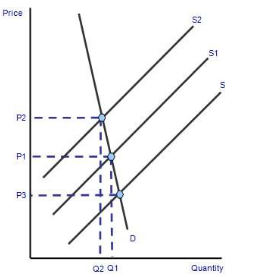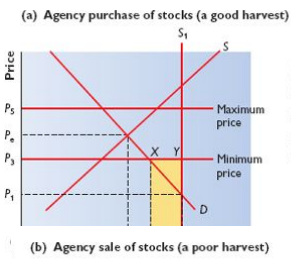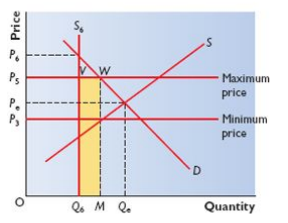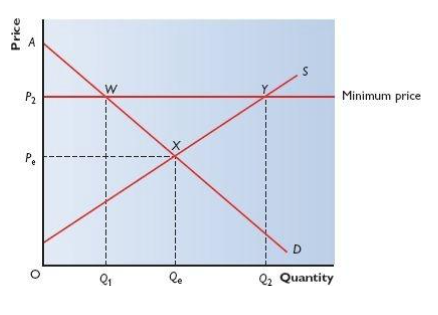Unstable Commodity Markets - A-Level Economics
Unstable Commodity Markets
Commodities are raw materials used in the production of goods. Examples include minerals (e.g. gold and copper) and agricultural goods (e.g. wheat and coffee).
Commodity markets are characteristised by fluctuating prices. Volatile prices fail to bring about a stable equilibrium-‐ there is market failure.
Volatile Prices: Causes
The reason for fluctuating commodity prices can be best illustrated by considering the agricultural market:

- Inelastic Demand-‐ agricultural products have very few substitutes and tend to be necessities. Moreover, each individual has a limited food intake, which does not really vary. Therefore, agricultural commodities tend to be price and income inelastic, so a shift in the supply curve will lead to a sharp change in price.
- Inelastic Supply-‐ it is very difficult to increase quantities of agricultural goods because growing takes a long time* and the goods are hard to store. Therefore, supply is price inelastic, and hence a shift in the demand curve will lead to a sharp change in price.
*There is a time lag between farmers deciding to increase supply (by planting seeds) and supply increasing when crops are fully grown.
- Unpredictable Supply-‐ weather and outbreak of disease are unpredictable factors which affect supply, and so supply continuously varies. The continual shifts in the supply curve lead to fluctuating prices.
In conclusion, the unpredictability of supply leads to constant shifts in the supply curve, which leads to changing prices. The inelastic nature of the demand curve makes these price changes even greater.
Volatile Prices: Effects
Volatile Prices have many effects on both consumers and producers:
Consumers
- Makes budgeting difficult
- Consumers find it hard to get an idea of the general price level (e.g. if the price of an apple kept on changing, how would you know the price a shop is selling an apple at is greater or smaller than the average price?)
- Uncertainty reduces consumer confidence and reduces the likelihood of them making big purchases
Producers
- Planning future output is difficult, so there is a fall in investment.
- Fluctuating Incomes
Rise in Price = Fall in Revenue
If good weather caused supply to shift from S1 to S2, farmers would have to lower prices to sell the excess stock. However, because demand is inelastic, to sell all of the produce, farmers would have to decrease prices greatly.

This fall in price causes revenue to fall (from yellow region to red region)
Fall in Price = Rise in Revenue
In contrast, if bad weather caused supply to shift from S2 to S1, the opposite would happen-‐ prices would rise and revenue would rise (from red region to yellow region).
Commodities: Global Prices
- Over the past few years, supply of agricultural goods has increased due to the improvement of technology (e.g. GM Foods).
- Demand has remained relatively constant
Therefore, prices of agricultural goods have fallen, reducing incomes of farmers.
Buffer Stock Schemes
If the commodity can be stored, a buffer stock scheme can be used to stabilise prices.
A buffer stock scheme is a scheme run by the government in order to stabilise fluctuating prices. The scheme involves the government buying and selling to the market as supply fluctuates.
Example: Buffer Stock Scheme for Cocoa

In times of a good harvest (an increase in supply) the price may be in danger of falling too low and so the government buys up the excess supply of the commodity, adding to its stockpile.
If there is a good harvest, supply will shift from S to S1, leading to a sharp fall in price. To keep the price at the minimum level, supply has to be no greater than L. Therefore, the government buys up the excess stock (Q1 – L) to bring supply down to L
🗶 Total Government Spending = LXYQ1

In times of a poor harvest (a decrease in supply) the price may be in danger of rising too high and so the government sells from its stockpile.
If there is a poor harvest, supply will shift from S to S6, leading to a sharp rise in price. To keep the price at the maximum level, supply has to be no lower than M. Therefore, the government sells stock (M – L) into the market to bring supply up to M.
- Total Government Revenue = MWVQ6
Assessment of Buffer Stock Schemes
Advantages
- Stable prices help stabilise producer’s incomes
- There is more certainty in the market, so investment increases
- Stable prices help consumer welfare because it prevents consumers being faced with very high prices and also helps overcome problems of budgeting and uncertainty that consumers face
- The scheme helps to ensure provision of commodities for consumers even in years of poor harvests (i.e. if there is a poor harvest, the government can sell stock to the market to prevent shortages)
- The government buy when price is low and sell when price is high. Therefore, in theory, the government should make profit which can be invested in the economy to improve social welfare.
Disadvantages
- Cannot be used for perishable commodities which cannot be stored
- High storage and management costs.
- The system needs to start with a good harvest, so that the stock can be built up. Buffer stocks could not be used in a situation of several years of bad harvest.
- Farmers might use the minimum price as insurance and therefore over‐produce because they know the government will buy up excess stock. This has economic impacts on the government (who have to spend a lot to buy up all this excess stock), as well as environmental problems (e.g. ripping up of hedgerows, soil degradation)
Evaluation: However, government policies have been implemented to prevent such over-‐production. For example, farmers are paid to keep land aside, and are also encouraged to turn areas of farms into tourist attractions or camping sites.
- There is less incentive for farmers to be efficient or to improve quality of goods-‐ this could lead to market failure.
- A series of good harvests can become very expensive for the government, and leads to a large stockpile. The government then has to decide what to do with the surplus stock (see minimum prices).
- A series of poor harvests can lead to the government running out of stock
- The minimum and maximum price bands are often inaccurately set by the government, due to asymmetric information between the government and producers.
- Opportunity cost of government spending on buffer stock schemes (e.g. money could be used to reduce taxes, improve healthcare etc.)
Minimum Prices
Another way for the government to stabilising prices and producer incomes is by setting a minimum price.
The minimum price is usually set above the free-‐market equilibrium price, causing demand to contract and supply to extend. This leads to excess supply, which the government agency buys up.

In this example, the agency sets the price at P2, above the equilibrium price. Supply extends from X to Y, whilst demand contracts from X to W. There is therefore excess supply (WY).
The farmer’s revenue increases from OPeXQe to OP2YQ2.
The agency’s total spending is Q1WYQ2.
Assessment of Minimum Price Schemes
Advantages
- Stable prices help stabilise farmer’s incomes, leading to more investment in farming
- There is more certainty in the market, so investment increases
- More stable prices helps consumer budget easily
- Farmers are important to maintain and protect the countryside, so by increasing their incomes we are preventing them leaving the farming industry to find higher paid jobs elsewhere.
- Employment in the countryside is maintained, helping to reduce urban-‐rural inequality.
- The scheme helps to ensure provision of commodities for consumers even in years of poor harvests (i.e. if there is a poor harvest, the government can sell stock to the market to prevent shortages)
- Agricultural surpluses can be used as foreign aid for poorer countries
Disadvantages
- Cannot be used for perishable commodities which cannot be stored
- The price of food increases, disadvantaging consumers, especially those on low incomes
- Opportunity cost of government spending (e.g. money could be used to reduce taxes, improve healthcare etc.)
- High storage and management costs
- Farmers might over-‐produce (see buffer stock schemes)
- There is less incentive for farmers to be efficient or to improve quality of goods-‐ this could lead to market failure.
- The price mechanism sends opposite signals to producers and consumers. Producers are told to increase their supply, whilst consumers to reduce their demand. This leads to a surplus which means there is an inefficient allocation of resources.
Evaluation: However, demand and supply for agricultural goods both tend to be inelastic, so the amount of surplus is minimal.
- There is the problem of what to do with the stored food:
- Selling it to global markets will increase global supply, forcing the price of food down, reducing farmer’s incomes
- Giving the surplus stock away as food aid helps others but it will reduce the incomes of farmer’s in those poorer countries, whilst again it increases global supply of food, reducing prices and farmer’s incomes
- The government can continue to store it, but costs of management and land makes this costly.
- Destroying it is wasteful and inefficient.
Commodity markets are markets where raw materials, such as metals, agricultural products, and energy, are bought and sold. These commodities are often used as inputs in the production of other goods and services, and their prices can have a significant impact on the global economy.
There are several factors that can contribute to instability in commodity markets, including changes in supply and demand, fluctuations in currency exchange rates, geopolitical tensions, and natural disasters. In addition, speculation and other forms of financial trading can also contribute to volatility in commodity markets.
Changes in supply and demand can have a significant impact on commodity prices. For example, if there is a sudden increase in demand for a particular commodity, but the supply remains the same, the price of that commodity is likely to increase. Similarly, if there is a decrease in demand for a commodity, but the supply remains the same, the price is likely to decrease.
There are several risks associated with trading commodities, including market risk, credit risk, and liquidity risk. Market risk refers to the risk that the price of a commodity will change in a way that negatively affects the trader’s position. Credit risk refers to the risk that the counterparty to a trade will default on their obligations, while liquidity risk refers to the risk that a trader will be unable to buy or sell a commodity at a fair price due to market conditions.
There are several policy options that governments and international organizations can use to address instability in commodity markets. These include measures to promote transparency and reduce speculation in commodity markets, as well as programs to support commodity producers and consumers. In addition, some countries have established commodity stabilization funds to help mitigate the impact of price fluctuations on their economies.
There are several strategies that individuals and businesses can use to protect themselves from commodity price volatility. These include hedging, which involves taking a position in the futures market that offsets the risk of price fluctuations, as well as diversification, which involves spreading investments across multiple commodities or asset classes. In addition, some businesses may choose to use long-term contracts to lock in prices and reduce their exposure to market volatility.






Still got a question? Leave a comment
Leave a comment